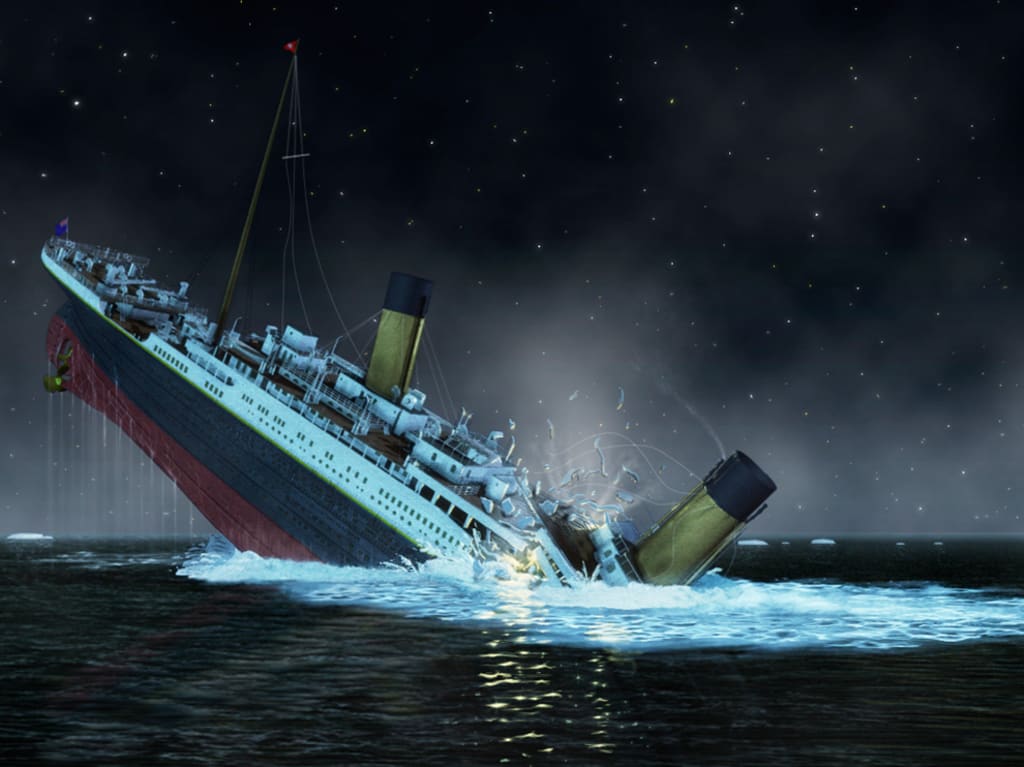The Tragic Tale of the Titanic
Unsinkable Dreams Shattered by an Iceberg

On the fateful night of April 10, 1912, the RMS Titanic, the world's largest and most luxurious ship of its time, embarked on its maiden voyage from Southampton, England to New York. The ship carried a diverse mix of passengers, from renowned industrialists and actors to hopeful immigrants seeking a better life in America. Commanded by the 62-year-old Senior Captain Edward John Smith, the Titanic was the epitome of opulence and grandeur, costing an astonishing $7.5 million in its day, equivalent to $400 million in today's terms when accounting for inflation.
The Titanic's interior was a spectacle of luxury, boasting stained glass mirrors, ornate wood paneling, two grand staircases, a heated swimming pool, a Turkish bath, an electric bath, a gym, a squash court, four restaurants, two barber shops, and a library. The ship's safety features, including its double bottom hull and division into 16 watertight compartments, led many to believe it was "unsinkable."
However, just two days into its voyage on April 12, 1912, the Titanic received its first ice warnings as it crossed the icy waters of the Atlantic Ocean. The crew received seven additional ice warnings on April 14, but Captain Smith and his crew continued to maintain the ship's speed at a rapid 21.5 knots, approximately 40 km/hr. The night of April 14 was marked by the absence of moonlight, reducing visibility and increasing the challenge of navigating the iceberg-laden waters.
At 11:39 PM, Fredrick Fleet, stationed in the crow's nest, spotted a massive iceberg directly in the ship's path. He rang the bell and made an urgent phone call to the officers on the bridge, alerting them to the impending danger. Unfortunately, their efforts to change course were in vain, and the Titanic collided with the iceberg at 11:40 PM. The impact left a significant dent in the ship's side and breached several compartments.
The collision shattered the belief in the Titanic's unsinkability, as the iceberg's size and weight caused extensive damage. Captain Smith and architect Thomas Andrews assessed the damage and realized the ship's fate was sealed. At 12:00 AM, Captain Smith ordered a distress call to be sent over the radio in hopes that nearby ships would come to their aid. The senior radio operator, Jack Phillips, tirelessly sent distress signals, with RMS Carpathia eventually responding. However, the Carpathia was 107 km away and could not reach the Titanic in time to save all passengers.
The chaos that ensued during the evacuation revealed the inadequacy of lifeboats. While there were only enough for approximately 1,200 people, the Titanic carried over 2,200 passengers and crew. Many passengers initially dismissed the seriousness of the situation due to the ship's "unsinkable" reputation, leading to half-empty lifeboats and tragic consequences.
As the ship slowly sank, more than 1,500 people met their demise, either drowning or succumbing to hypothermia in the frigid waters, with a temperature of -2 degrees Celsius. The captain, Edward Smith, remained at the helm and may have perished alongside the ship.
The rescue by RMS Carpathia arrived too late to prevent the tragedy, and the disaster exposed a series of errors and oversights. The lack of adequate lifeboats, a cancellation of safety drills, misinterpretation of navigation orders, and the pressure to maintain high speeds all contributed to the catastrophe. The failure of the nearby ship SS Californian to respond to distress signals and warnings further exacerbated the situation.
The sinking of the Titanic spurred significant changes in maritime safety regulations. The International Ice Patrol was established in 1914 to alert ships about icebergs in their path. The International Convention for the Safety of Life at Sea (SOLAS) set new standards, including the requirement for an adequate number of lifeboats for all passengers. The Titanic's wreckage was discovered in 1985 by ocean explorers, but the ship's metal framework is gradually disintegrating due to environmental factors.
Despite the passage of over a century, the Titanic's tragic story continues to captivate the world's imagination. Efforts to build a replica, known as Titanic 2, have been ongoing but have faced delays and challenges, partly due to concerns that it lacks modern amenities like TV and Wi-Fi. The Titanic's legacy endures as a haunting reminder of the perils of hubris and the importance of safety at sea.
About the Creator
Enjoyed the story? Support the Creator.
Subscribe for free to receive all their stories in your feed. You could also pledge your support or give them a one-off tip, letting them know you appreciate their work.





Comments
There are no comments for this story
Be the first to respond and start the conversation.